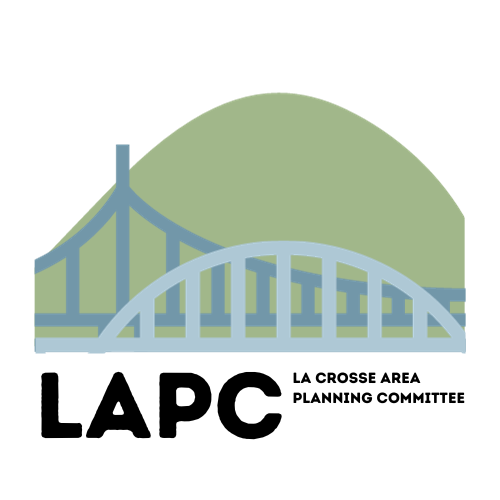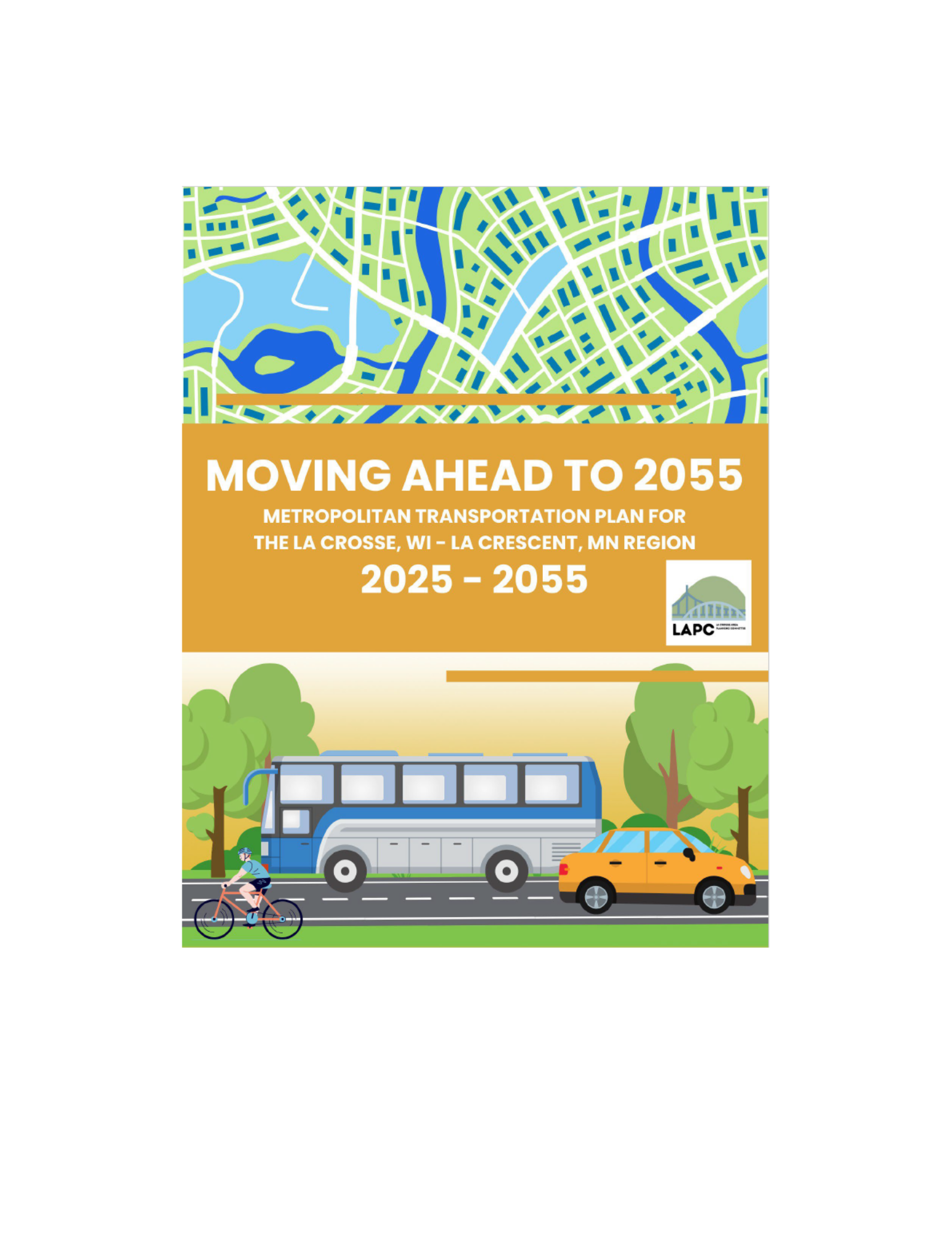
Metropolitan Transportation Plan


2025 METROPOLITAN TRANSPORTATION PLAN UPDATES
LAPC is currently in the process of updating the long-range Metropolitan Transportation Plan.
VIEW THE DRAFT PLAN HERE:
Moving Ahead to 2055 Draft Document
Moving Ahead to 2055 Appendices
30-day Public Comment Period is now open! The comment period will conclude on September 16, 2025, at 5 p.m., with our Policy Board reviewing and approving the Plan the following day at its September 17, 2025, meeting at 4:30 p.m.
First Open House:
Monday, August 18 from 4 to
5:30 p.m. at the Town of Onalaska Town Hall, N5589
Commerce Road, Onalaska, WI 54650.
Second Open House:
Tuesday, August 19 from 4 to 6
p.m. at the La Crosse County Administration
Building, Room 1107, 212 6th St N, La Crosse, WI 54601. This open house is
accessible by Downtown MTU bus service.
For those who cannot make it in-person, can attend the second open house virtually on August 19 from 4 to 6 p.m., to ask any questions. Any person may access this meeting utilizing the following options.
+1 262-683-8845,,841117613#
United States, Allenton
Phone conference ID: 841 117 613#
For more information, reach out to Erin Duffer at [email protected] or 608-785-5597.
Yog tias koj xav tau kev pab tshwj xeeb lossis txhais ua lwm hom lus kom pom LAPC cov phiaj xwm lossis
phiaj xwm, thov hu rau Erin Duffer ntawm 608-785-5597.
Si necesita adaptaciones especiales o traducción a otro idioma para ver los planes o programas de LAPC, comuníquese con Erin Duffer al 608-785-5597
As required by the Fixing America’s Surface Transportation (FAST) Act and its predecessors, the La Crosse Area Planning Committee (LAPC) as the Metropolitan Planning Organization (MPO) for the La Crosse, WI – La Crescent, MN urbanized area must review and update a long-range, metropolitan transportation plan (MTP) every five years. This ensures that the plan is valid and consistent with current and forecasted transportation and land use conditions and trends and that the forecast period extends to at least a 20-year planning horizon.
The scope of the metropolitan transportation planning process includes:
- Considering 10 planning factors
- Utilizing a performance-based approach
- Coordinating with the statewide transportation planning process
- Consistency with the development of applicable regional intelligent transportation systems architectures, and
- Ensuring the coordinated public transit-human services transportation plan is coordinated and consistent with the MPO planning process.
 Beyond Coulee Vision 2040 (6.3MB) approved on September 16, 2020 is our current MTP, which updates and replaces Coulee Vision 2040 (14MB) approved on September 16, 2015. The environmental review for BCV 2040 is documented in the Natural and Cultural Resource Inventory.
Beyond Coulee Vision 2040 (6.3MB) approved on September 16, 2020 is our current MTP, which updates and replaces Coulee Vision 2040 (14MB) approved on September 16, 2015. The environmental review for BCV 2040 is documented in the Natural and Cultural Resource Inventory.
The planning process for the next update will occur over the next five years with approval in 2025.
Transportation Demand Management (TDM)
Beyond Coulee Vision 2040 prioritized using TDM measures as an alternative to widening and/or constructing new roads when possible. The plan is consistent with previous actions of the LAPC and builds on the 2016-2017 LAPC planning initiative in which member communities summarized existing conditions and identified potential TDM activities.
Traditionally, TDM has focused on policies and strategies to encourage a shift away from single-occupancy vehicle (SOV) trips toward alternative travel options like walking, biking, transit, and ridesharing to address traffic issues. The Federal Highway Administration (FHWA) in its guide, Integrating Demand Management into the Transportation Planning Process, defines TDM as "...providing travelers, regardless of whether they drive alone, with travel choices, such as work location, route, time of travel and mode. In the broadest sense, demand management is defined as providing travelers with effective choices to improve travel reliability."
To continue addressing traffic management, LAPC staff worked with the LAPC Technical Advisory Committee (TAC) to develop a list of feasible TDM best practices for urban, urbanizing, and rural communities in the planning area. The TDM best practices outlined below are meant to assist our local governments address traffic issues (congestion, increased volumes, etc.) in their communities. The list provides a menu of TDM options for communities to consider. The LAPC is aware that “one-size does not fit all” when it comes to managing traffic and it is recommended that local governments review the list and utilize the “best practices” that will best meet their goals.
Land Use Policies and Practices
- Encourage higher density development and smaller residential lots within urban communities and residential subdivisions of rural communities - Higher density development (compact) increases the feasibility of transit services.
- Continue collaborative planning and boundary agreements between jurisdictions.
- Eliminate off-street parking minimums or establish parking maximums for new developments reducing the number of parking stalls and area needed for development (more applicable to urban areas).
- Require the consideration of transit and traffic impacts from proposed developments in incorporated communities. Prioritize development incentives (TID, etc.) for projects served/compatible with transit.
- Ensure developments can connect to one another through easements and/or land reserved for future transportation infrastructure.
- Increase bicycle and pedestrian trails and connections to reduce vehicles on roadways. In planning documents identify bike/pedestrian facilities/options.
- Plan for workforce housing near employers.
Parking Policies and Practices
- Consider implementing a demand-based pricing system for on-street parking (cost increases as demand increases). To encourage turnover, long-term parking should not be permitted.
- Reduce subsidized parking and consider parking fees that reflect the actual cost of parking.
Employer-sponsored Actions
- Employee transit benefits and subsidies (transit passes, reduced fares, etc.).
- Employer-organized and hosted vanpools and carpools.
- Priority parking for carpools (close to the door).
- Housing assistance programs.
- Provide secure and sheltered bike parking.
- Flexible work schedules and/or alternate work schedules.
- Telework options.
Public Transportation Agency Polices and Practices
- Simplified automated fare structure and payment with seamless transfers between providers.
- Accurate real-time arrival information across transit services.
- Expand transit services with more routes/frequencies and encourage new transit options.
- Compatible transit schedules (schools, work shifts, other providers/modes).
- Develop a regional trip planner for transit providers serving the La Crosse commuter shed.
Information and Education Opportunities
- Bicycling safety classes sponsored by schools (SRTS) and the Wisconsin Bicycle Federation.
- Employers marketing the benefits of walking/biking/transit to work options.
Other TDM Considerations
- Infrastructure-bike lanes, sidewalks, trails, etc.
- Support/promote bike share programs like Drift Cycle in La Crosse.
- Increase the number of and transit connections to park-and-ride lots in the region.
- Management of work zones and route closures (timing, traveler information, etc.).

